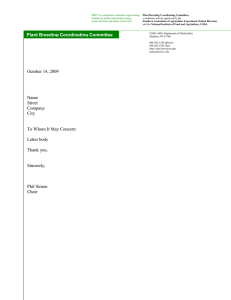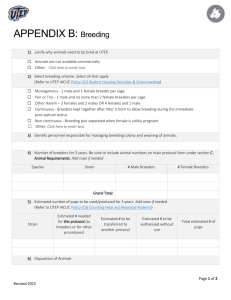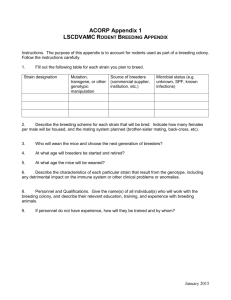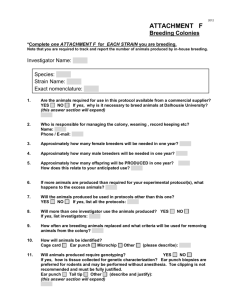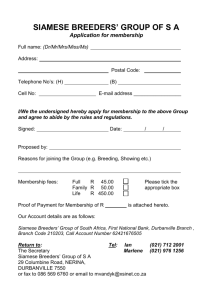National Association of Plant Breeders Todd C. Wehner, Professor
advertisement
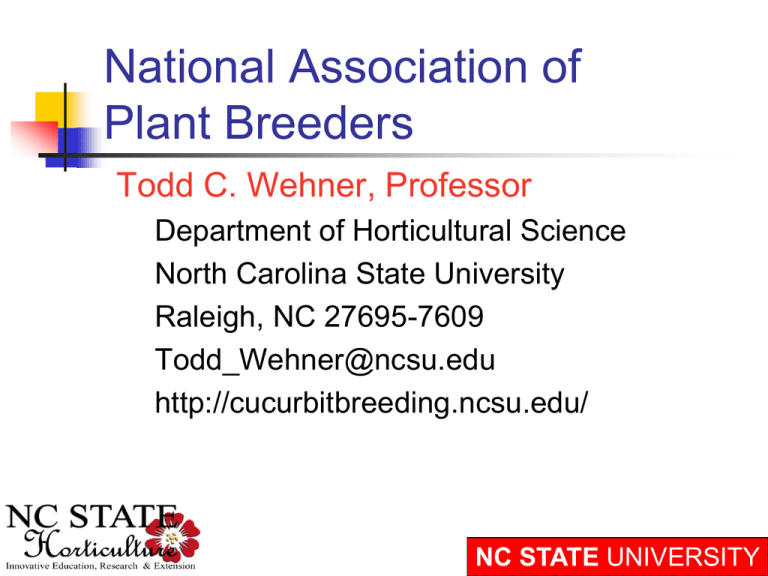
National Association of Plant Breeders Todd C. Wehner, Professor Department of Horticultural Science North Carolina State University Raleigh, NC 27695-7609 Todd_Wehner@ncsu.edu http://cucurbitbreeding.ncsu.edu/ NC STATE UNIVERSITY Who are we? National Association of Plant Breeders Represents all plant breeders All crops (field crops, horticultural crops, forestry) Public and private sectors Mainly U.S. plant breeders, but membership includes internationals Formed by Plant Breeding Coordinating Committee at the national meeting in 2009 Who are we? Plant Breeding Coordinating Committee Multi-state coordinating committee: SCC-080 Based in southern region experiment stations but national in scope, and membership open to all Formed in 2006 First workshop held February 2007 Who are we? Plant Breeding Coordinating Committee 'a forum for issues, problems and opportunities of strategic importance for contribution of plant breeding to national goals' Who are we? National Association of Plant Breeders Groups represented: Land-grant universities USDA-ARS Seed industry Non-government organizations, including organics Crops represented: Fruits, vegetables Grains, legumes Ornamentals, flowers, turfgrasses Forage, fiber crops, forest trees Who are we? National Association of Plant Breeders Officers: Philipp Simon (USDA-ARS), president Todd Wehner (NC State Univ.), vice-president Rita Mumm (Univ. Illinois), secretary Seth Murray (Texas A&M Univ.), web editor Stephen Baenziger (Univ. Nebraska), past-pres. Who are we? National Association of Plant Breeders Liaisons: Stephen Baenziger, CGIAR Centers Paul Gepts, CGIAR Centers Bill Tracy, Private Non-Profit Breeders Fikret Isik, Forestry Plant Breeders Pat Byrne, Crop Science Society Amer. Plant Breeders Karl Glasener, Amer. Soc. Agronomy Caron Gala, Amer. Soc. Agronomy Linda Wessel-Beaver, Amer. Soc. Hort. Sci. Plant Breeders Amy Iezzoni, Amer. Soc. Hort. Sci. Plant Breeders Tom Koch, Nat. Commercial Council of Plant Breeders Who are we? Plant Breeding CC Representatives: George Askew, Administrative advisor Ann Marie Thro, NIFA representative Roy Scott, USDA-ARS representative Randy Johnson, US Forest Service representative Why do we exist? National Association of Plant Breeders Private plant breeders: increased significantly in 1900s due to changes in intellectual property laws took over some crop improvement duties Public plant breeders: Research: new traits, methods Teaching: future plant breeders Breeding: develop new cultivars especially: wheat, peanut, sweetpotato, grape Why do we exist? National Association of Plant Breeders Plant breeding is many activities Collect germplasm (public) Research new breeding methods (public) Train graduate students (public) Develop improved germplasm (public, private) Release new varieties (public, private) Why do we exist? National Association of Plant Breeders Plant breeding is many activities Collect germplasm (public) Research new breeding methods (public) Train graduate students (public) Develop improved germplasm (public, private) Release new varieties (public, private) Public plant breeding survey Conclusions - 2002 Few universities have plant breeding programs 1 or 2 universities per U.S. region (52+17=69 land-grant universities) 53% of graduates from just 7 universities Public plant breeders remaining are poorly funded Retiring public breeders may not be replaced Wehner and Guner, 2002 (plantbreeding.ncsu.edu) Plant Breeding Students Trained in U.S., 1995-2000 (per year) Total Domestic International Land Grant University degrees Ph.D. M.S. Ph.D M.S. All universities 124 25 34 40 24 Univ. Wisconsin-Madison North Carolina State Univ. Univ. Nebraska-Lincoln Cornell Univ. Univ. Minnesota Iowa State Univ. Texas A&M Univ. Michigan State Univ. North Dakota State Univ. Oregon State Univ. 12 11 10 9 8 7 7 6 5 5 4 1 1 3 3 2 1 2 1 1 3 4 2 1 2 2 2 2 2 1 3 4 5 5 2 2 3 1 2 3 3 2 3 1 1 1 1 1 1 1 Wehner and Guner, 2002 (plantbreeding.ncsu.edu) Problem National Association of Plant Breeders Public breeders needed Private breeders do not publish research Private breeders do not educate students U.S. needs 200 PB students/year U.S. trains 120 PB students/year Private breeders do not work on all crops Thanksgiving dinner will not exist! Rolls, sweetpotatoes, cranberries, wine Why do we exist? National Association of Plant Breeders Plant breeding is many activities Collect germplasm (public) Research new breeding methods (public) Train graduate students (public) Develop improved germplasm (public, private) Release new varieties (public, private) What are we doing? National Association of Plant Breeders Promoting communication among breeders Assembling information on plant breeding Different sectors: federal, state, private, non-profit Different crops: agronomy, horticulture, forestry Where are the breeding programs? How should we train students? Share courses using distance education? Identifying research, education priorities Developing support for plant breeding What are we doing? National Association of Plant Breeders Financial support needed Plant breeding programs are expensive to run Projects often not short-term; grants are! Competitive grants may lead to 'fad breeding' Hatch funding should provide the base! How can we help NIFA? National Association of Plant Breeders Global food security and hunger Climate change High yield: more food, feed, fiber without using more land Develop new varieties that resist heat and drought may also need chilling resistance Sustainable energy Breed new varieties of existing crops: sweetpotato Develop new crops for biofuels: switchgrass How can we help NIFA? National Association of Plant Breeders Food safety Develop crops that resist food pathogens Less-netted cantaloupes resist pathogen transfer Childhood obesity Breed for high flavor, high nutrition Carrots have 50% more (1975) carotene now more flavor, color; consumption up 30-40% QuickTime™ and a decompressor are needed to see this picture. What do we want? National Association of Plant Breeders Current support for genotyping centers a good idea Provide resources for breeding Centers are efficient (shared over regions) genotyping phenotyping transformation doubled haploids for 'instant inbreds' What do we want? National Association of Plant Breeders Support for: Plant breeding programs on all crops, even if there are private breeders on that crop public private efforts are complementary What do we want? National Association of Plant Breeders Federal support needed: fellowships in plant breeding support for centers of excellence in breeding competitive grants for plant breeding more years per grant Hatch funds for experiment station support Breeding is a long-term project! virus, nematode, mildew resistance National Assoc. Plant Breeders More information See web page at: Plant Breeding CC PlantBreeding.com PlantBreeding.org Or, contact one of the officers National Assoc. Plant Breeders Thank you Questions? Why do we exist? National Association of Plant Breeders Highlights of plant breeding: Plant domestication Green revolution Heterosis Disease resistance Nutritionally-enhanced foods Who are we? Plant Breeding CC Groups represented: Land-grant universities USDA-ARS Seed industry Non-government organizations, including organics Crops represented: Fruits, vegetables Grains, legumes Ornamentals, flowers, turfgrasses Forage, fiber crops, forest trees Number of plant breeders in the public and private sectors in the U.S. in 1994 and 2001. Crops SAES 1994 2001 USDA-ARS Private sector 1994 1994 2001 Total 2001 1994 2001 Grain 246 200 54 89 903 1026 1203 1315 Fiber 20 24 13 11 103 123 136 157 Forage 38 27 33 13 51 65 122 105 Sugar 4 4 15 0 25 4 44 8 Vegetables 99 55 22 25 268 123 389 203 Ornamentals 18 39 5 0 64 83 87 122 Fruit & Nut 60 41 29 23 32 12 121 76 Lawn & Turf 15 16 0 0 41 9 56 24 Others 28 18 6 0 10 100 44 118 528 424 177 161 1497 1545 2202 2130 Total From: Frey (1996), Traxler et al. (2005), Morris et al. (2006) Plant Breeding Students Trained in the U.S., 1995-2000 Total Domestic International Land Grant University degrees Ph.D. M.S. Ph.D M.S. All universities 743 151 202 243 147 Univ. Wisconsin-Madison North Carolina State Univ. Univ. Nebraska-Lincoln Cornell Univ. Univ. Minnesota Iowa State Univ. Texas A&M Univ. Michigan State Univ. North Dakota State Univ. Oregon State Univ. 72 64 61 54 48 44 41 36 33 28 22 7 5 18 16 13 9 10 3 4 18 21 10 5 11 13 10 12 13 5 16 26 27 27 13 12 18 8 11 16 16 10 19 4 8 6 4 6 6 3 Wehner and Guner, 2002 (plantbreeding.ncsu.edu) Who are we? Plant Breeding CC Officers: Philipp Simon (USDA-ARS), chair Todd Wehner (NC State Univ.), vice-chair Rita Mumm (Univ. Illinois), secretary Seth Murray (Texas A&M Univ.), web editor Stephen Baenziger (Univ. Nebraska), past-chair Elisras Derdepoort Marken Potgietersrus T habazimbi Bray Zeerust Mmabat ho T wee Rivieren Stella Van Zylsrus Vryburg Kuruman Oliphantshook Upington Groblershoop Pret oria Johannesburg Why do we exist? National Association of Plant Breeders Basic principles of plant breeding: Agriculture - the foundation of civilization Plant breeding - the foundation of agriculture Who are we? Plant Breeding CC Committees (each with chair and secretary): Grand challenges Science, technology and informatics Communications and outreach Awards and nominations Education and training of plant breeders What do we want? National Association of Plant Breeders Federal support: AFRI competitive grants program Specialty crops research initiative Germplasm collection program Germplasm evaluation program Crop Genetics Committees Germplasm Resources Information Network Hatch (formula) funding for experiment stations QuickTime™ and a decompressor are needed to see this picture.
